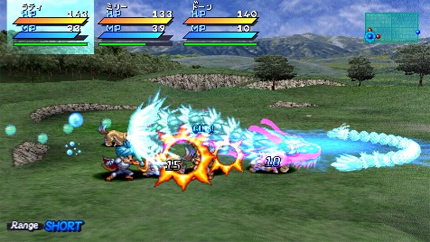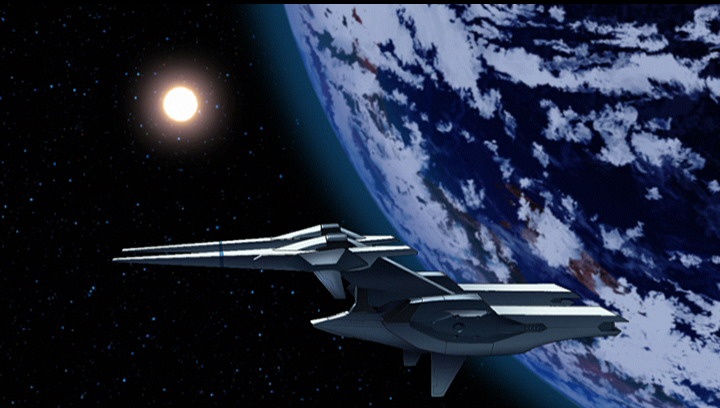Star Ocean: First Departure is an enhanced remake of Star Ocean, the original Super Famicom classic and progenitor of Tri-Ace's most renowned franchise. The game has received several graphical improvements for its Western debut, highlighted by impressive anime cutscenes courtesy of the popular anime-house, Production I.G. It retains the hallmarks of the series, including a fast-paced, real-time battle system and a highly robust crafting element. But it soon deteriorates into empty button-mashing combat and a ton of tedious backtracking vaguely related to a narrow, mediocre plot. Pretty cutscenes and crafting simply cannot mask its overall shallowness.

The game opens on the primitive planet Roak, where a disease is turning people to stone. Roddick, a simple country guard, is searching for a cure but so far has come up short. Soon, however, he is joined by two Earthlings who transport him into the past with the hope of obtaining a vaccine. The overall plot is quite bland, with almost no side quests, but it is accentuated by brief character dialogues called "private action scenes" intended to add depth and intrigue. Unfortunately, this leads to roaming cities in search of new scenes, which may occasionally help you unlock party members, but are rarely informative or useful.
The bulk of the gameplay occurs on an almost barren 3D world map, where you use an improved onscreen minimap with a convenient zoom feature to locate castles and villages. Battles are random and utilize a very quick, real-time battle system in which you control the party leader while the competent AI manages your teammates. The system allows for precise strategic control by enabling you to set party tactics either across the board or individually, and as is customary with the series, you're free to switch between party members even midfight for more direct intervention. You can now roam the battlefield to dodge attacks or switch targets, which is a great improvement that more closely links the game to the rest of the series.
Though the battle system has finally joined the 21st century, it quickly grows wearisome because of the game's barebones three-hit combos, lack of enemy variety, and limited skill slots that restrict your melee leader to two special attacks. Little to no strategy is involved even for boss fights, and while some enemies exhibit elemental weaknesses, they rarely impact skill or spell usage. This results in a lot of monotonous button mashing. You may also find it difficult to outmaneuver or block attacks, which is especially irritating when you're being pummeled from all sides and the targeting reticle is locked bouncing between foes.
When you're tired of battling enemies, you may enjoy exploring the comprehensive skill system and crafting options, which provide nearly all of the game's depth. Skill points, which are acquired by leveling, can be spent on skills to learn special abilities once you've mastered them in the right combination. For example, in order to master art, you need to distribute skill points into both aesthetics and sketching. There are numerous abilities for you to unlock, including item appraisal, crafting, and cooking. These should please item collectors, but unlocking them is largely an unnecessary, time-consuming venture given the ease with which you require money and items. You'll probably find it more useful to spend skill points to directly modify character stats for greater character customization or to enhance combat by unlocking special battle abilities that ignore enemy defense, decrease casting time, and the like. A final set of skills exists for additional tweaking, called specialties and super specialties, which activate unique skills that adjust experience or skill points earned in battle.
Star Ocean's most disappointing aspect is that it feels devoid of everything except random battles and an optional crafting system. There aren't that many villages to explore and even fewer quests. There are few full dungeons to complete as well, and those that you are given are easy to navigate. In fact, there's not much for you to do other than shop and enjoy pretty cutscenes. Tri-Ace compensates for this lack of "stuff" by requiring frequent backtracking, which usually culminates in another cutscene that orders you straight back to where you came from--on the other side of the world. There is a port system that will normally take you to a sister port on another continent, but the majority of travel is done on foot between landlocked villages. This frequent backtracking is accompanied by pointless random battles against foes you defeated 20 levels ago and combines with slightly overpowered casters to make the game so easy that you can often set the PSP aside to let your party members do all the work for you.
Every element of the presentation has been significantly updated, beginning with the inclusion of Production I.G.'s beautiful, vibrantly colored anime cutscenes that are so striking it's confusing as to why they're so rarely utilized. Full dialogue voicing complements these sequences and is rarely annoying except during battles, when characters tend to scream out their attacks as they spam them. Character sprites are now more colorful, and the sharp, prerendered environments that are the game's most obvious visual improvement are highly detailed. However, you may now find it difficult to locate the proper entrances and exists because they tend to blend in with the walls. Battle environments are 3D, but they are just as bland as the world map, although spell effects and special abilities are quite flashy, enlivening any fight. Music is very reminiscent of the Super Nintendo era and usually consists of charming melodies that provide a good exploration backdrop.

You should finish the main quest line within 20 hours, which is normally a healthy range for portable RPGs, but in this case, you'll spend the majority of your play time watching cutscenes, backtracking, or demolishing vastly underpowered foes by mashing the action button. The intensity does increase after you reach the epilogue, where a second quest and a bonus dungeon open up. However, it's a short segment and a shame that the gameplay is such a breeze until the end. Unlocking new characters or crafting extends the game a bit, but the crafting is rather useless considering that everything is cheap and it's so easy to make money.
Star Ocean: First Departure offers good fanfare with stunning anime sequences and a fresh look. However, it's also padded with backtracking, crafting, and cutscene dialogue that hide its sparse dungeons, as well as its quests. There are simply too many better RPGs on the market that offer pretty visuals and depth to broaden Star Ocean's appeal.